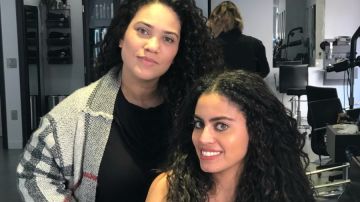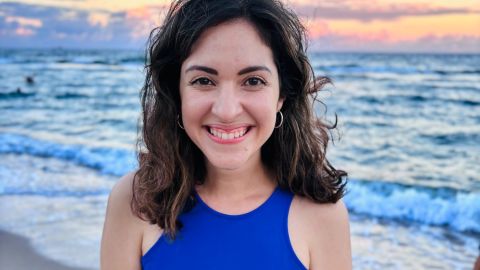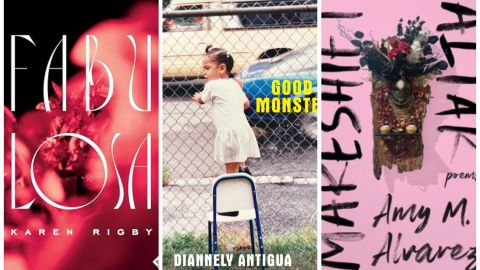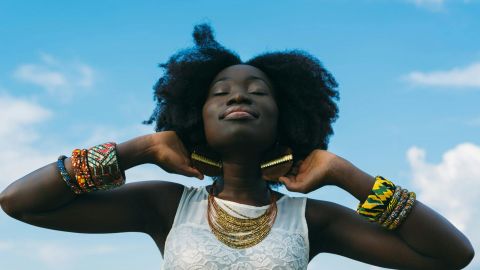I Got My Hair Cut By Dominican Curl Expert The Hair Saint
Nurturing my curls back to health has been quite the journey

Photo: Courtesy of Johanna Ferreira
Nurturing my curls back to health has been quite the journey. The one thing you need to have when transitioning from heat-damaged hair to healthy curls is patience — there’s no question about it. I have had a few haircuts since the damage — trims and even a lob back in 2017 — but the two things that made the biggest difference were getting a curl cut and finally laying low on the heat. After getting my first curl cut this past fall and almost four months of no heat-styling at all, I was finally ready to get my hair fully transformed by none other than highly sought after hairstylist and curl expert, Ona Diaz-Santin Ó, a.k.a The Hair Saint.
If you have curly hair and live in the NYC metropolitan area — or New Jersey — chances are you’ve heard of Ona. Her name is mentioned quite often within the curly community and it’s for good reason. Ona knows her shit. Period. She has cut the hair of many influential curly haired Latinas. She gave fitness expert and influencer, Massy Arias her big chop. Curl expert and founder of Miss Rizos Salon in the Dominican Republic, Carolina Contreras swears by Ona’s cuts. In fact, when I interviewed Carolina this past fall, she highly suggested I make an appointment with Ona.
What really sets Ona apart from a lot of the curl stylists out there, is that she isn’t afraid to challenge the status quo. Ona isn’t out here doing things like everyone else. Every single client that sits in her chair gets a completely customized experience. From the shampoo bowl to the cut and down to the styling, Ona caters to the individual’s texture and hair needs. She doesn’t treat curls with a one-size-fits-all mentality. Because of that you walk out of her salon not just feeling like your best self but having learned a lot about how to style and care for your curls.
The second I walked into Ona’s 5 Salon Spa in Bergen County, New Jersey, I knew it was worth the trip from Brooklyn. Ona is Dominicana, which would explain her warm, friendly, and very nurturing persona. She greeted me with a big hug and kiss the second I stepped in her salon and welcomed me with a full breakfast — I’m talking cheese, bread, a fruit spread — and fresh fruit juice. Before we even made our way to her chair, Ona sat me down to discuss what we were going to do. This is part of her process. She gives you the opportunity to discuss your hair needs, wants, and goals. Then she goes in and fully observes your hair.
I expressed to her that I wanted more shape and volume, while maintaining most of my length. Ona made sure to honor that while also keeping it real about what had to be cut. I also expressed that I usually part my hair in the middle.
“Your ends are a little see-through, there’s still a little damage here,” she tells me. “So we’re going to bring it up at least an inch by trimming those ends off. It would solidify that length so it doesn’t look so see-through and wimpy. A lot of times when your ends look really see-through it makes your hair look thin and lifeless. If you want full, luscious hair, those ends need to be cleaned up. We’ll leave the length nice and blunt.”
Once we figured out how much we were trimming, then Ona broke down how we were going to create shape and volume.
“The next step is going into the interior part. Because you part your hair in the middle, we’re going to do the cut with the hair parted in the middle,” she explains. “However you wear your hair is how it should be cut. That’s important. You’re not going to create a part where it doesn’t live because you’re not going to actually wear your hair that way.”
This is what I mean when I say, Ona doesn’t do things quite like anyone else. She takes every single detail from how you part your hair to the products you’re going to use into consideration — it’s an art and a science with her.
“Then going into the interior part of the hair we’re going to add some layers. We can do a combination of techniques,” she says. “We’ll add layers to lighten up the interior part of the crown area and then we want to leave your front fairly long. Layers will be the technique but we can’t keep them all long. You already have long layers and they aren’t doing anything for you. To really bring out your curls we need to create shape so we can really see them.”
Once we got that down, Ona went on to explain to me that she was going to cut my hair wet. I was initially surprised since my previous curly cut was done dry and most curly experts swear by dry curl cuts. Ona believes that how you choose to cut curly hair really does depend on the texture.
“I think there’s a big discrepancy in the curly hair community that you can only cut curly hair dry and that’s a big fat lie,” she says. “With my clients it really depends. Some of them I cut dry and others I cut wet — it really depends on the type of curl pattern, how thick or course the hair is, and what the hair does. Many of my clients with curlier, coarser hair I’ll cut it dry but on finer textures, I’ll often cut it wet. I think people think a curly cut is a Devacut and that’s not true. That’s one type of curl cut. The Devacut is a great concept. They filled a void that wasn’t there. But not everyone can be cut that way.”
Having grown up in the salon business, Ona understands the importance of being able to work with not some, not most — but ALL hair textures.
“I grew up in the salon. My mom owned four Dominican hair salons: One in New Jersey, two in Queens, and one in Manhattan. I grew up in that environment so [me becoming a stylist] was bound to happen,” she says.
Having started in the Dominican salon business, Ona became known for blow drying but after being inspired to embrace her own curls, she decided to use her own experience to help her clients embrace their natural curls and transition to healthy hair. She went through her heat-damage transition period right after high school. After years of only wearing her hair straight, Ona’s blow dryer died on her the day of her high school graduation. She was forced to go with her curls and was shocked at all the positive feedback she received — despite the damage. A few hours before her second date with her now-husband, Ona’s blow dryer died on her again. She almost canceled the date but fortunately, she didn’t and her husband absolutely adored her curls.
Growing up in the hair salon exposed Ona to terms like “pelo malo” and for years she thought she had “bad hair.”
“When I was little my mom used to keep my hair very short. She would style it straight and keep it short because it was too much work for her, so for years I wondered if I had bad hair because my mom expressed she didn’t want to deal with,” she says. “She never said that to me but I heard the words “pelo malo” in the salon constantly when referring to curly hair textures.”

Photo: Courtesy of Johanna Ferreira
It was her own transitioning process and journey to loving her hair that made her realize how important it is to also help people fight the negative thoughts or lies society condition them to believe about their own hair.
“For me serving the curly hair community is important because it’s more than just the physical. It’s a psychological thing too,” she tells me. “I think it’s deeper than just how we look at ourselves. Our culture doesn’t allow for change easily and we’ve been conditioned to believe that we look best with our hair worn straight. I’m here to be a rebel — a good rebel — that helps women and tells them hey it’s your hair. God made you that way so love your hair. It doesn’t mean you can’t blow out your hair. You can blow out your hair — I occasionally do. It just means to take care and embrace what you have.”
Sitting in Ona’s chair is like therapy. She doesn’t just talk you through the process but she makes you feel good about the hair that naturally grows from your scalp. That’s a big deal considering the centuries of brainwashing we’ve endured when it comes to natural hair. Despite the few pieces of damage my hair still has, Ona still made sure to talk about my hair in a positive way only, while encouraging me to continue on with my curl journey. She told me if I continued to lay off the heat, all I’d need is a few more cuts before my curls reach their bounciest and healthiest state.
“I think a lot of us have a hold because of our culture and our backgrounds. “It’s not just Latinas either,” she says. I have Black clients, I have Jewish women sitting in my chair with very curly hair — even Asian women with a few waves and texture and hate it because in their culture it’s considered a negative thing. This is a global problem and I’ve noticed that just in my chair. Being around hair allows me to really see that a lot of women across the globe struggle with embracing their hair texture due to cultural influences. I use this as an opportunity to teach women to love and embrace their hair.”
Once we discussed the cut, Ona breaks down the types of products she was going to use on my hair. She explains to me that the type of products she uses depends on the client’s hair needs. My curls are on the finer side and my scalp tends to get oily, because of that Ona didn’t opt to co-wash my hair. Instead, she used a balanced shampoo that lathers.
“Cleansing conditioners and co-washes are great but they don’t necessarily work for everyone and depending on your texture you shouldn’t always co-wash,” she says. “I don’t co-wash because I have very fine oily hair. This whole idea that lather is bad for curls isn’t true. It doesn’t necessarily dry out curls. Once again, it all depends on your curls — not all curls are the same. I have clients who only co-wash and I have clients who have to use shampoos that lather.”
She explains to me, that how your curls look all starts with the shampoo bowl. “If you’re not washing your hair properly, what makes you think your curls are going to look dope? It’s about pre-prepping, washing, and styling — meaning using the right products and the right technique and of course, getting the right cut,” she says.
I brought my styling products with me so that Ona could explain to me how to use them properly. She said to opt for a leave-in conditioner that’s lighter and less creamy, so it wouldn’t weigh down my curls. She approved the gel I’ve been using which is the Camile Rose Curl Maker because the density is light enough for my texture. But she did suggest considering a light-weight foam as well, something I’m definitely going to try in the future. She overemphasizes that saturation makes all the difference and explains to me the importance of really raking in products, before scrunching with a microfiber towel to prevent frizz.
Anyone that knows me, knows I dread cutting my hair. I don’t even look forward to trims because I’ve had way too many experiences in the past where stylists have gone scissor crazy. But things felt different with Ona. I didn’t feel like the paranoid, picky client with heat-damage PTSD that’s afraid of losing length. I felt like a normal client (with curls that have been through hell and back) that just wants a stylist who understands and respects that. Ona gave me that. So much so, that I immediately booked my next cut for July. My curls look instantly curlier, bouncier, and fuller than before. My curls literally haven’t looked this good since I was little. Imagine how great they’ll look after the next cut? I can officially say that now I actually look forward to getting my hair cut. Who would have thought?

















